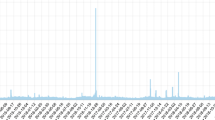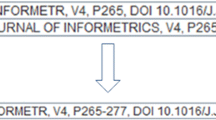Abstract
Both scienticity and artistry have been listed in cluster concept definitions for both science and art. However, these clusters have not been considered together before. I contrast and combine these different clusters for the first time, and I argue that doing so better elucidates the properties of the natural sciences, humanities and fine arts than the science and art cluster concepts do separately. This is because all disciplines have varying levels of scienticity and artistry, but this is not captured fully by the science or art cluster concepts separately. An integrated scienticity and artistry cluster provides a new way of describing the commonly argued notion that the sciences and arts share qualities, methods and practices, but the integrated scienticity-artistry cluster shows how, when and where these qualities blend into each other across disciplines.
Similar content being viewed by others
Notes
“The Work of Lucian Freud – Paint as Flesh” <http://www.winsornewton.com/row/discover/articles-and-inspiration/work-of-lucian-freud-paint-as-flesh-us-row?lang=gb>
“The Gustav Klimt Drawings: Inside the Mind of a Master Draftsman” <http://chrisoatley.com/gustav-klimt-drawings/>
“The Balcony 2” <https://www.artgallery.nsw.gov.au/collection/works/116.1981/>
“Paul Simon Solo”, 1987, Paul Simon interviewed by Mark Steyn. BBC TV.
References
Anderson, R. L. (1990). Calliope’s Sisters: A Comparative Study of Philosophies of Art. Englewood Cliffs: PrenticeHall.
Blocker, H. G. (1994). The Aesthetics of Primitive Art. Lanham: University Press of America.
Bohm, D. (1998). On Creativity (ed. Lee Nichol). London: Routledge.
Bond, E. J. (1975). The Essential Nature of Art. American Philosophical Quarterly, 12, 177–183.
Brecht, B. (2015). Marc Silberman, Steve Giles and Tom Kuhn (ed.), Brecht on Theatre (Third ed.). London: Bloomsbury Methuen Drama.
Briggs, J. (1992). Fractals The Patterns of Chaos: Discovering a New Aesthetic of Art, Science, and Nature. New York: Simon & Schuster.
Bunge, M. (1984). What Is Pseudoscience? The Skeptical Inquirer, 9, 36–51.
Byrne, D. (2013). How Music Works. San Francisco: McSweeney’s.
Einstein, A. (2011). Calaprice, A. (ed.) The Ultimate Quotable Einstein. Princeton: Princeton University Press.
Davies, S. (2010). The Cluster Theory of Art. Philosophical Perspectives on Art. New York: Oxford University Press, 39-42.
Derksen, A. A. (1993). The Seven Sins of Pseudoscience. Journal for General Philosophy of Science, 24(1), 17–42.
Dissanayake, E. (1990). What is Art For? Bellingham: University of Washington Press.
Dupré, J. (1993). The Disorder of Things: Metaphysical Foundations of the Disunity of Science. Cambridge: Harvard University Press.
Dutch, S. I. (1982). Notes on the Nature of Fringe Science. Journal of Geological Education, 30(1), 6–13.
Dutton, D. (2009). The Art Instinct. New York: Oxford University Press.
Ellmann, R. (1987). Oscar Wilde. New York: Vintage Books.
Feyerabend, P. (1975). Against Method. London: Verso Books.
Feyerabend, P. (1984). Wissenschaft als Kunst. Suhrkamp: Frankfurt am Main.
Fokt, S. (2014). The Cluster Account of Art: A Historical Dilemma. Contemporary Aesthetics, 12. <http://www.contempaesthetics.org/newvolume/pages/article.php?articleID=705>
Gaut, B. (2000). “Art” as a Cluster Concept. In N. Carroll (Ed.), Theories of Art Today (pp. 25–44). Madison: University of Wisconsin Press.
Gaut, B. (2005). The Cluster Account of Art Defended. BJA, 45, 273–288.
Grove, J. W. (1985). Rationality at Risk: Science against Pseudoscience. Minerva, 23(2), 216–240.
Gruenberger, F. J. (1964). A measure for crackpots. Science, 145, 1413–1415.
Hansson, S. O. (2009). Cutting the Gordian Knot of Demarcation. International Studies in the Philosophy of Science, 23(3), 237–243.
Hoban, P. (2014). Lucian Freud: Eyes Wide Open. London: New Harvest.
Husserl, E. (2002). Philosophy as Rigorous Science (trans: Reynor Jr., Philip). In Burt Hopkins and Steven Crowell (eds.) The New Yearbook for Phenomenology and Phenomenological Philosophy II . New York: Routledge, 249–295.
Jemison, M. (2002). On Teaching Arts and Sciences Together. TEDGlobal2002, February 27–March 2, Monterey. http://www.ted.com/talks/mae_jemison_on_teaching_arts_and_sciences_together?language=en.
Kandel, E. (2012). The Age of Insight: The Quest to Understand the Unconscious in Art, Mind and Brain, From Vienna 1900 to the Present. New York: Random House.
Kitcher, P. (1982). Abusing science: The case against creationism. Cambridge: MIT Press.
Langmuir, Irving, ([1953] 1989). Pathological Science. Physics Today, 42(10), 36–48.
Lawrence-Lightfoot, S. (2005). Reflections on Portraiture: Dialogue Between Art and Science. Qualitative Inquiry, 11(3), 3–15.
Lock, A. (2014). Uniting the Sciences and Arts. Philosophy and Literature, 38(1A), A178–A194.
Longworth, F., & Scarantino, A. (2010). The Disjunctive Theory of Art: The Cluster Account Reformulated. British Journal of Aesthetics, 50(2), 151–167.
Mahner, M. (2013). Science and pseudoscience: How to demarcate after the (alleged) demise of the demarcation problem. In Massimo Pigliucci and Maarten Boudry (eds.) Philosophy of Pseudoscience. London: University of Chicago Press, 29-44.
McKenzie, E. (2016) Sculpting ideas: can philosophy be an art form?. Philosophy and Literature, 40(1), 34–43.
Moravcsik, J. (1993). Why Philosophy of Art in a Cross-Cultural Perspective? The Journal of Aesthetics and Art Criticism, 51, 425–436.
North, J. D. (1923). The Case for Metal Construction. The Journal of the Royal Aeronautical Society, 27, 11.
Pennock, R. T. (2011). Can’t Philosophers Tell the Difference between Science and Religion? Demarcation Revisited. Synthese, 178(2), 177–206.
Pigliucci, M. (2013). The demarcation problem: A (belated) response to Laudan. In Massimo Pigliucci and Maarten Boudry (eds.) Philosophy of Pseudoscience. London: University of Chicago Press, 9–28.
Ramachandran, V. S. (2011). The Tell-Tale Brain: A Neuroscientist’s Quest for What Makes Us Human. New York: Norton.
Richmond, S. (1984). The Interaction of Art and Science. Leonardo, 17(2), 81–86.
Root-Bernstein, R. (1989). How Scientists Really Think. Perspectives in Biology and Medicine, 32(4), 472–488.
Root-Bernstein, R., & Root-Bernstein, M. (2004). Artistic Scientists and Scientific Artists: The Link Between Polymathy and Creativity. In R. Sternberg, E. Grigorenko, & J. Singer (Eds.), Creativity: From Potential to Realization. Washington D.C.: American Psychological Association.
Rosenberg, M. (2010). Jazz and Emergence--Part One: From Calculus to Cage, and from Charlie Parker to Ornette Coleman: Complexity and the Aesthetics and Politics of Emergent Form in Jazz. Inflexions, 4, 183–277.
Rosenfield, L. W. (1971). Aristotle and Information Theory: A Comparison of the Influence of Causal Assumptions on two Theories of Communication. The Hague: Mouton and Co..
Ruse, M. (Ed.). (1996). But is it science? The philosophical question in the creation/evolution controversy. Buffalo: Prometheus Books.
Snyder, L. J. (2011). The Philosophical Breakfast Club: Four Remarkable Friends who Transformed Science and Changed the World. New York: Broadway Books.
Toon, A. (2012). Models as Make-Believe: Imagination, Fiction, and Scientific Representation. Basingstoke: Palgrave Macmillan.
Weitz, M. (1956). The Role of Theory in Aesthetics. The Journal of Aesthetics and Art Criticism, 15, 27–35.
Werrett, S. (2010). Fireworks: Pyrotechnic Arts and Sciences in European History. London: University of Chicago Press.
Acknowledgements
Thanks to an anonymous reviewer, Maartin Boudry, Dustin Hellberg and Gregory Tague for helpful comments on an earlier draft.
Author information
Authors and Affiliations
Corresponding author
Rights and permissions
About this article
Cite this article
Lock, A. Scienticity and Artistry Across All Subjects. Philosophia 46, 355–377 (2018). https://doi.org/10.1007/s11406-017-9887-z
Received:
Revised:
Accepted:
Published:
Issue Date:
DOI: https://doi.org/10.1007/s11406-017-9887-z




